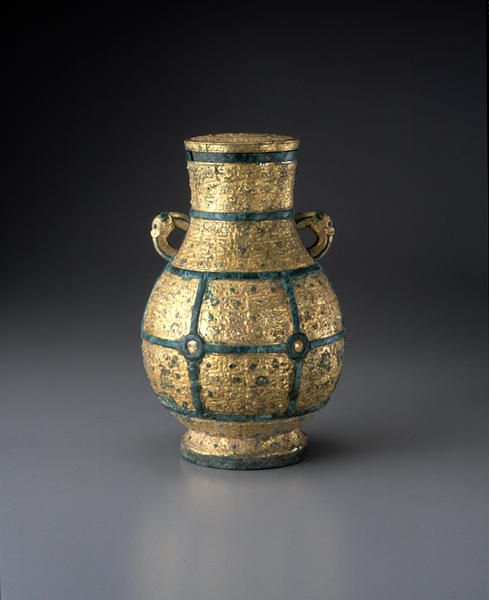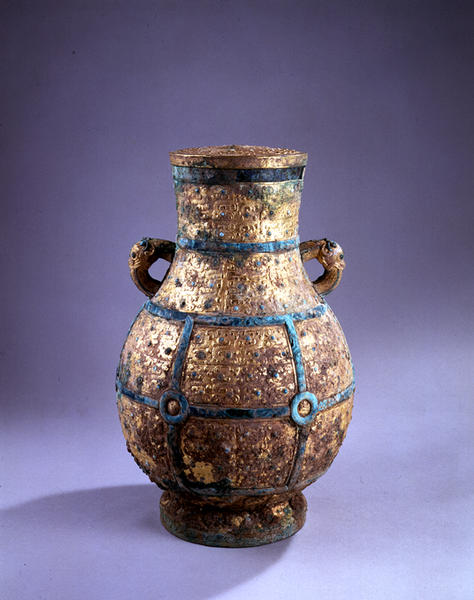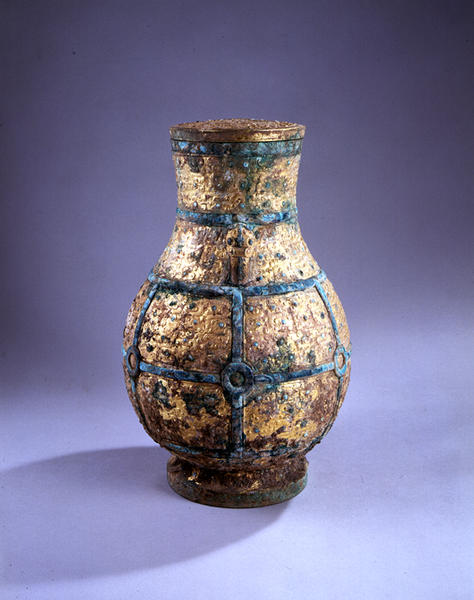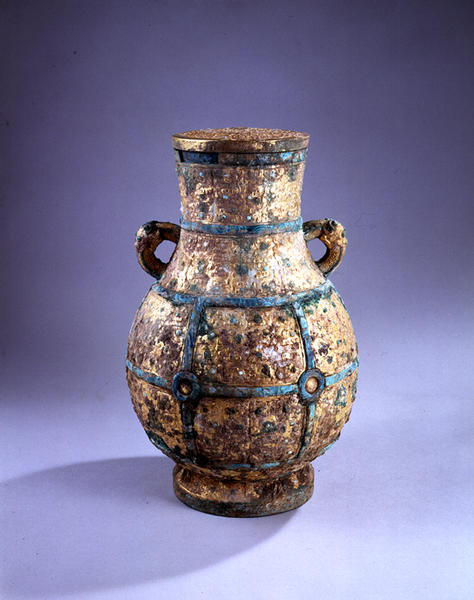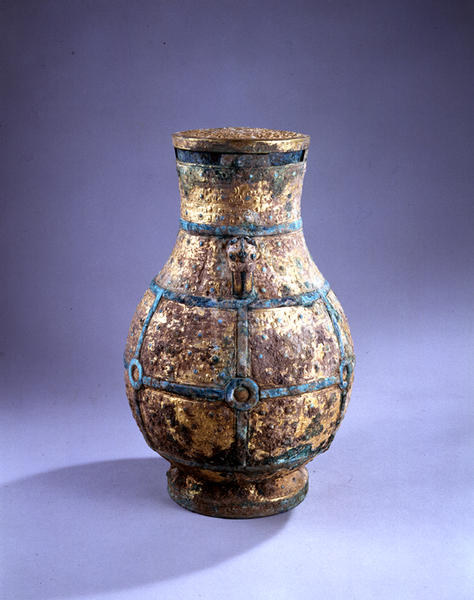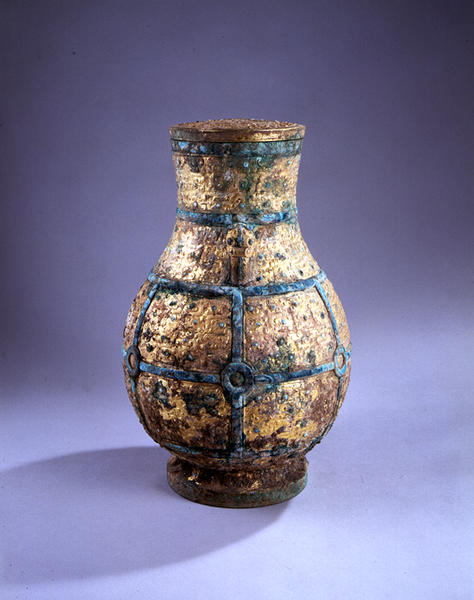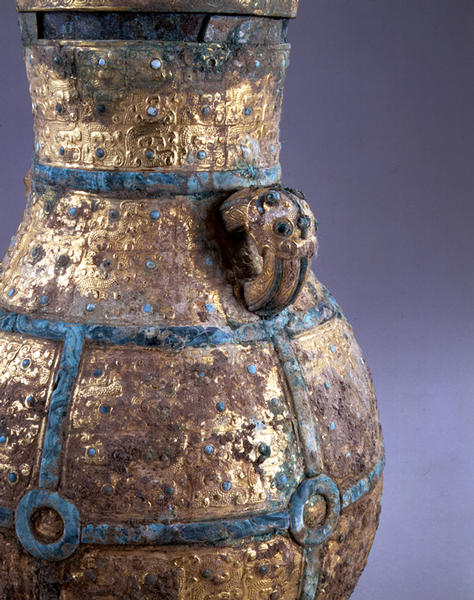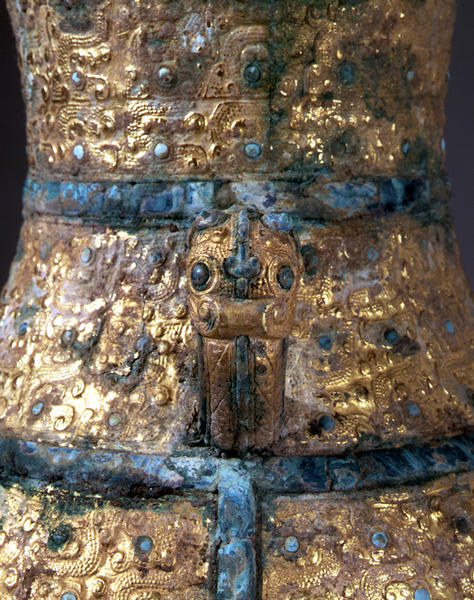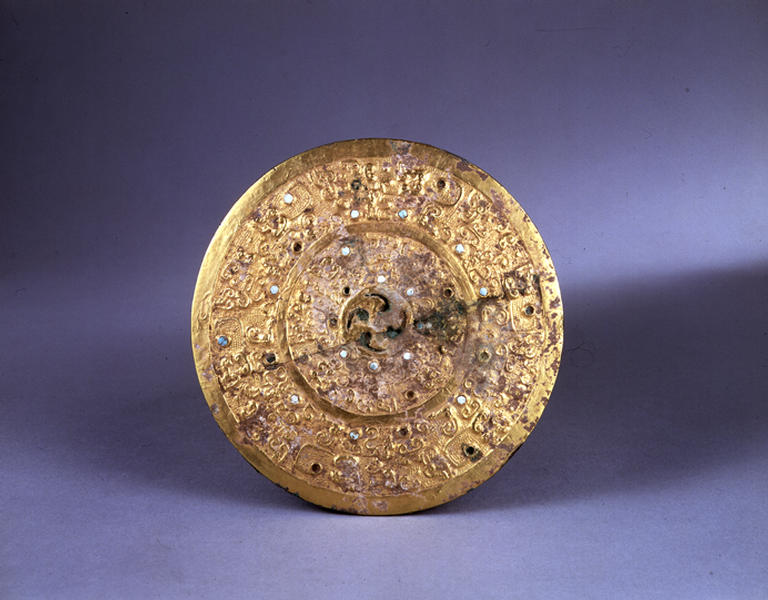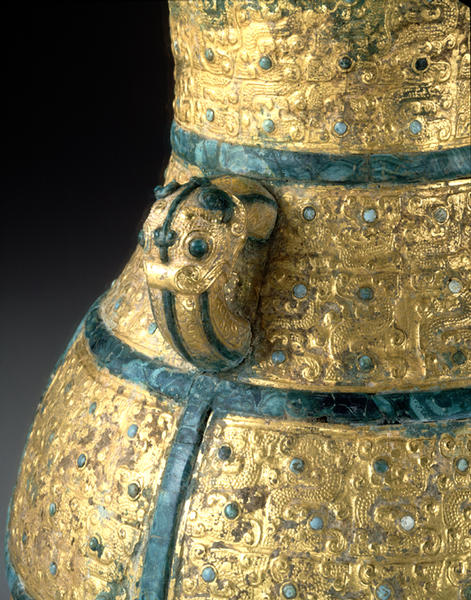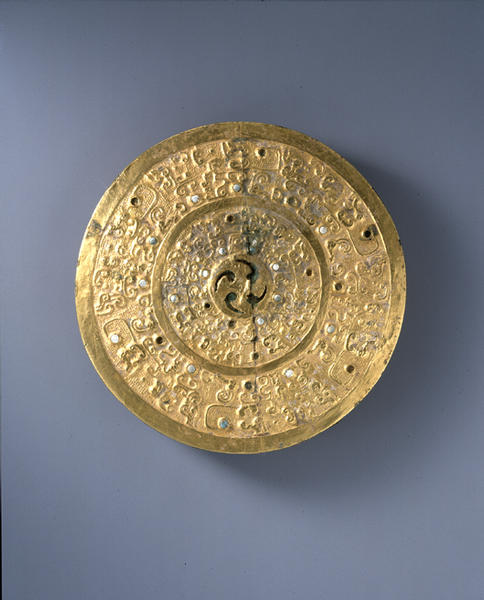貼金青銅壺
- 中国・東周時代末(紀元前6世紀-紀元前5世紀)
- 6-5cB.C.
- 青銅、金、孔雀石
- H-31.4
解説(開館1周年記念展)
この青銅製の壷は胴の中程で膨らみ,肩の両側に環耳を付け,口縁は上部でやや広がっている。器の曲面にそって削られた孔雀石の象嵌で,膨らんだ胴部に絡縄の意匠を造りだし,口縁と環耳の上部にも孔雀石の帯が巡らされて,器胎を大きく五つの層に分けている。器壁は金の薄板で覆われ,押し出しで器胎の龍文を浮き上がらせている。基本的な龍の意匠はS字形にうねる龍体の末端に龍の横顔が付けられ,孔雀石の帯で区切られた最上段とその下の環耳の付けられた段,および最下段の圏足の部分には龍の目に孔雀石が象嵌されている。胴部の絡縄文の施された二つの段は龍口に孔雀石が象嵌され,玉をくわえる格好になっている。
環耳には渦巻く角と巻き上がった鼻先をもった獣頭が付けられ,角,目,頭部の正中線に孔雀石が象嵌されている。器口には青銅製の平らな蓋が被せられているが,その表面にも金の薄板が被せられ,押し出しで,中央に四巴文とそれを囲む内圏およびその外側の円で区切られた外圏に,穀粒地の只中に龍文くずしが表され,要所に規則的に孔雀石の象嵌が施されている。
この丸い壷の形態は春秋末期から戦国時代にかけて見られるようになったもので,絡縄意匠は戦国前中期の青銅壷にしばしば使われている。環耳の獣頭表現,器胎と蓋に見られる龍文は山西省侯馬出土の陶範にその類似の意匠を見ることができる。*1
青銅や他の物質に金の薄板を被せる技法は古くから見られるが,実例は少ない。この壷と同時代のものには装飾金具のような小型の類例が見られ,夢蝶軒コレクションの帯鉤のように,青銅の芯を使って金を型枠鋳造した後,金表面の意匠を更に明瞭に削り出したもの,P. ウルドリー・コレクションの環状装飾のように,青銅の本体に金の薄板を被せて押し当て意匠を浮き出させているものもある。*2 どちらの類例も侯馬の陶範に近似した意匠をもっているが,このような大きな壷全面に同様の技法を適応したものは今のところ他に類例を見ない。
1 山西省考古研究所/侯馬陶範芸術/Institute of Achaeology of Shanxi Province/Art of the Houma Foundry/Princeton 1996
2 J. M. White & E. C. Bunker/Adornment for Eternity/Denver 1994 no.6; P. Uldry/Chinesisches Gold und Silber/Zurich 1994 no.12
Catalogue Entry
This bronze vessel with ring handles on both sides is wide in the middle of the body, and its mouth is slightly flared at the upper part. The wide body is inlaid with carved malachite in a tied rope pattern along its curves. There are malachite bands around the mouth and above the ring handles, as well. The vessel is divided into five horizontal sections by the bands. The dragon pattern on the vessel was made by covering the body with gold sheet and tracing the pattern. The dragon motif is basically S-shaped with a profile at each end of the body. In the uppermost section of the vessel, as divided by the horizontal malachite bands, in the part just below it, in which the handles are fixed, and in the lowest part, the dragons' eyes are inlaid with malachite. In the two middle parts of the body with the design of the tied rope pattern, the dragons' mouths are inlaid with malachite, as if the dragons were holding jade in their mouths.
An animal head with a coiled horn and rolled up snout is fixed on each of the ring handles. The horns, the eyes, and the center line of the head are inlaid with malachite. The vessel is covered with a flat bronze lid, plated with gold, which has a whirl design at the center and abbreviated dragon patterns traced by pressing. Several malachite tips are inlaid on the lid.
The round shape of this vessel appears in the late Spring and Autumn period or early Warring States period, and the tied rope pattern was often used on bronze vessels from the early to middle parts of the Warring States period. Examples with patterns similar to the animal heads on the ring handles, and the dragon pattern of the body and lid can be found in ceramic molds excavated at Houma in Shanxi province.*1
The ornamentation technique of covering bronze or other materials with gold leaf has been known since ancient times, but very few examples remain. In the Mengdiexuan collection, there is a belt-hook made using the technique of gold being cast in a mold over a bronze core, with the gold surface being chased to express the design more clearly. In the P. Uldry collection, there is an ornament with a ring covered with gold sheet, on which the design has been expressed in repousse.*2 In these examples, the surface design is similar to that of the Houma example, but there are no other vessels of this size which have decorations in the same technique.
